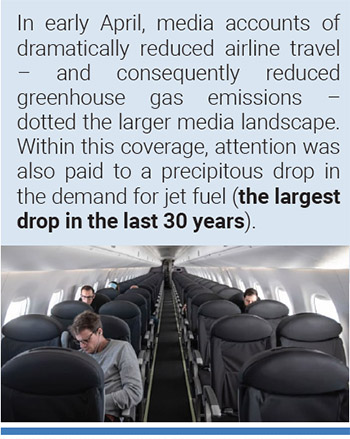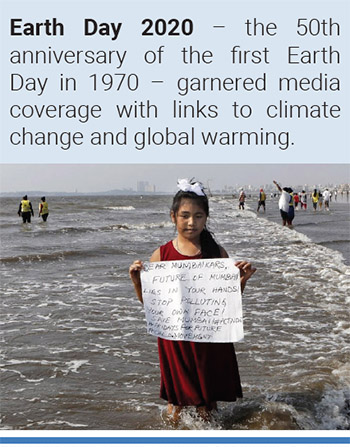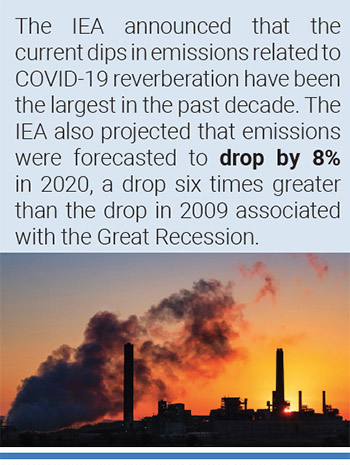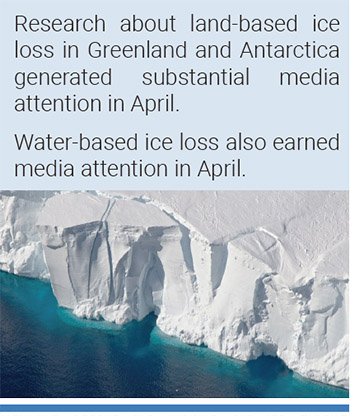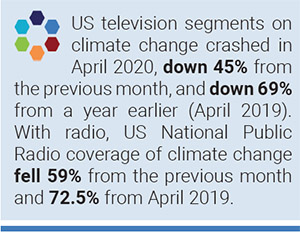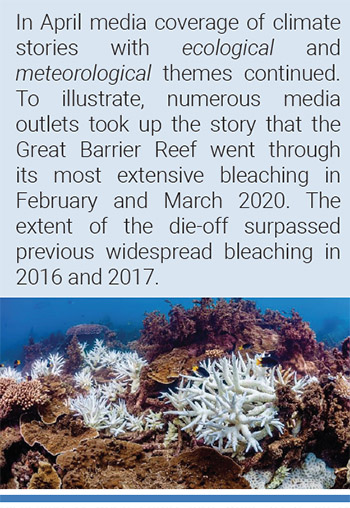Monthly Summaries
Issue 40, April 2020
[DOI]
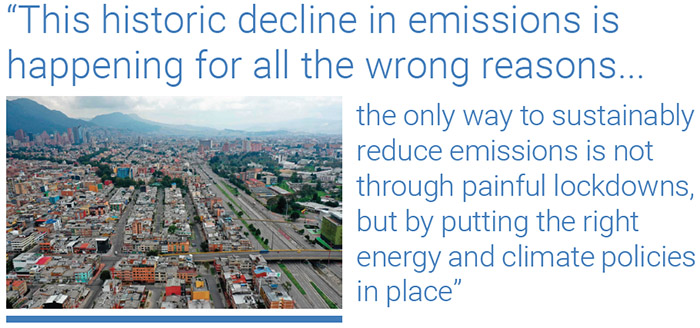
Empty roads in Bogota, Colombia after quarantine was imposed on the city. Photo: Raúl Arboleda/AFP via Getty.
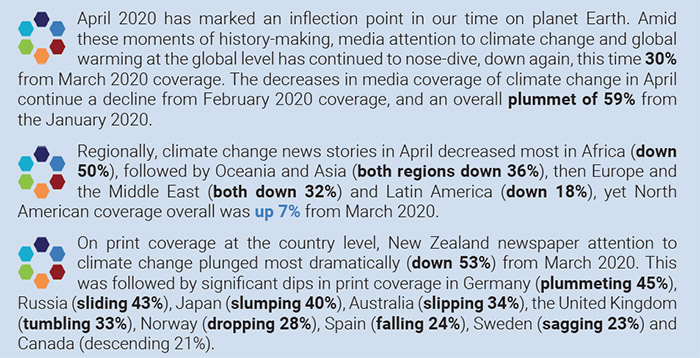
April 2020 has marked an inflection point in our time on planet Earth. Amid these moments of history-making, media attention to climate change and global warming at the global level has continued to nose-dive, down again, this time 30% from March 2020 coverage. The decreases in media coverage of climate change in April continue a decline from February 2020 coverage, and an overall plummet of 59% from the January 2020. Furthermore, compared to a year earlier (April 2019), the number of news articles and segments about climate change and global warming is 40% lower. Regionally, climate change news stories in April decreased most in Africa (down 50%), followed by Oceania and Asia (both regions down 36%), then Europe and the Middle East (both down 32%) and Latin America (down 18%), yet North American coverage overall was up 7% from March 2020 (more below).
Figure 1 shows trends in newspaper media coverage at the global scale – organized into seven geographical regions around the world – from January 2004 through April 2020.

Figure 1. Newspaper media coverage of climate change or global warming in print sources in seven different regions around the world, from January 2004 through April 2020.
Figure 2. Word cloud showing frequency of words (4 letters or more) invoked in media coverage of climate change or global warming in United States newspaper sources in April 2020. Data are from The Los Angeles Times, The New York Times, USA Today, The Wall Street Journal and The Washington Post. |
On print coverage at the country level, New Zealand newspaper attention to climate change plunged most dramatically (down 53%) from March 2020. This was followed by significant dips in print coverage in Germany (plummeting 45%), Russia (sliding 43%), Japan (slumping 40%), Australia (slipping 34%), the United Kingdom (UK) (tumbling 33%), Norway (dropping 28%), Spain (falling 24%), Sweden (sagging 23%) and Canada (descending 21%).
However, United States (US) newspaper coverage bucked all these trends, with a 29% increase in April 2020 compared to March 2020, and 16% higher than a year earlier (April 2019). Keeping this in context, these numbers were still down 22% from January 2020 and down 6% from February 2020 coverage of climate change. Connections between ‘coronavirus’, ‘Trump’ and ‘climate change’ drove significant coverage, where ‘Trump’ was explicitly mentioned on average 7.5 times and ‘coronavirus’ or ‘COVID’ were 7.3 times on average in each US newspaper article on climate change (see Figure 2). Greater general attention paid to climate change and public health, as well as coverage of the US-derived ‘Earth Day’ events and a renewed ‘Covering Climate Now’ campaign were also seen to primarily drive this increase in April. Yet, attention paid to coronavirus and Trump without mention of climate change are considered to primarily drive this continued overall decrease in coverage from the January and February of this year.
As such, in the US we have detected a re-emergence (detected in previous months and years) of a significant amount of news from US outlets on climate change or global warming associated with Donald J. Trump. We at MeCCO have referred to this as a ‘Trump Dump’, where media attention that would have focused on other climate-related events and issues instead was placed on Trump-related actions, leaving many other stories untold. However, in this case it may be that without the news hook of President Trump – in the face of a finite news hole filled with stories of COVID and coronavirus – even more climate change news stories in the US would have gone untold like trends around the rest of the world.
Yet, an increase in media representations of climate change was limited to print coverage. US television segments on climate change crashed in April 2020, down 45% from the previous month, and down 69% from a year earlier (April 2019). With radio, US National Public Radio coverage of climate change fell 59% from the previous month and 72.5% from April 2019.

Figure 3. Japanese newspaper media coverage of climate change ‘温暖化’ or global warming ‘気候変動’ in print sources in Asahi Shimbun, Yomiuri Shimbun, and Mainichi Shimbun in April 2020.
Photo of an almost-empty passenger plane. Photo: Laurel Chor, Getty Images. |
Moving past the quantity of coverage and digging into the content, media accounts in April drew on cultural themes, interlinked with political, economic, scientific and ecological/meteorological themes (described below). In early April, media accounts of dramatically reduced airline travel – and consequently reduced greenhouse gas emissions – dotted the larger media landscape. Within this coverage, attention was also paid to a precipitous drop in the demand for jet fuel (the largest drop in the last 30 years). For example, Guardian journalist Oliver Milman reported, “The coronavirus outbreak has provoked a string of unsettling sights, such as the sudden widespread use of masks, shuttered businesses and deserted streets. Another unusual phenomenon is also playing out in the skies – near-empty airplanes flying through the air…. Widespread travel restrictions around the world have slashed demand for air travel, with more than eight in 10 flights canceled. But there is a disparity in the US – while the Transportation Security Administration (TSA) has reported a 96% slump in passenger volume, to a level not seen since 1954, this hasn’t been matched by the number of flights being scrapped. A spokesman for United said it was “still somewhat rare” for a single passenger to be on a flight and said that the company had made investments in more sustainable fuel to lower its carbon footprint. The commitment of airlines in general to addressing the climate crisis has been questioned during the coronavirus shutdown, however. Airlines are lobbying to rewrite the rules of a global agreement designed to tackle aviation emissions, with the coronavirus outbreak expected to make its targets tougher to meet. Campaigners accused airlines of attempting to “dodge their obligations”, but the industry said it was “a matter of survival”.”
Earth Day 2020 – the 50th anniversary of the first Earth Day in 1970 – garnered media coverage with links to climate change and global warming. For example, CBS News journalist Sophie Lewis reported, “an ongoing 3-day live stream from 9 a.m. to 9 p.m. on April 22, 23 and 24 across streaming platforms. The stream [was] hosted by The U.S. Climate Strike Coalition and Stop The Money Pipeline Coalition, which are made up of over 500 environmental organizations. Dozens of celebrities, politicians, scientists, journalists and activists [were] participating, including Al Gore, Amber Tamblyn, Chelsea Handler, Jameela Jamil, Jane Fonda, Joaquin Phoenix, Secretary John Kerry, Mark Ruffalo, Mayor Lori Lightfoot, Representatives Alexandria Ocasio-Cortez and Rashida Tlaib”.
Environmental activist Licypriya Kangujam, 8, stands at Juhu beach during a cleaning drive in Mumbai, India. Photo: Rajanish Kakade/AP. |
Stories also circulated in April about how younger people seem to be capably pivoting to online environments as they continue to share their concerns about climate change. For example, Associated Press journalists Martha Irvine and Christina Larson penned a piece called ‘Young climate activists slowed by pandemic, but not defeated’. They wrote, “Unable to gather en masse as they’d planned this Earth Day, these activists are planning livestreams and webinars to keep the issue of climate front and center on the world stage and in the U.S. presidential race”.
Further adding to re-emergent cultural themes in April media coverage, the ‘Covering Climate Now’ project was rejuvenated around Earth Day (or more accurately Earth Week) virtual activities around the world. More than 400 outlets around planet Earth took part. For example, Guardian staff noted, “Even as the coronavirus pandemic terrorizes the world, there’s another global emergency the media can’t afford to stop covering. Fifty years ago this week, the environmental movement staged the first Earth Day demonstration to call attention to environmental degradation and demand reform. In the half century since, climate change has emerged as an existential global threat. But there are still reasons to be hopeful… the Guardian is joining forces with hundreds of newsrooms around the world to focus attention on creative solutions to the climate emergency, from electric cars to fighting plastic waste to using psychedelic drugs… The Guardian is the lead partner in Covering Climate Now, an initiative founded last year by Columbia Journalism Review and the Nation to address the urgent need for stronger climate coverage. More than 400 newsrooms from around the world – with a combined audience nearing 2 billion people – have signed on”.
"Now more than ever it is important to cover one of the most pressing issues in our lifetimes,” said Al Roker, who announced the collaboration on the NBC News TODAY show. Source: https://www.coveringclimatenow.org. |
In April, political and economic content continued to contribute substantially to media coverage of climate change or global warming. To begin, in the first days of April the United Nations announced that they were postponing the Conference of Parties meeting (COP26) originally scheduled to take place in November in Glasgow, Scotland. Stories abounded. For example, BBC journalist Matt McGrath reported, “A key climate summit in Glasgow will be delayed until next year due to disruption caused by the coronavirus. The announcement was made in a joint statement from the UK and UN after a "virtual" meeting of officials. Dozens of world leaders were due to attend the COP26 gathering that was set to run in Glasgow from November 9 this year. It is expected that the conference will now take place by the middle of next year”. Washington Post reporters Brady Dennis and Chris Mooney added, “The postponement of the meeting comes as global emissions have continued to rise, although many experts now think that trend will temporarily reverse due to the pandemic and its impact on global travel, energy use, and the economy. In 2019, emissions are estimated to have set a new all time high of 36.8 billion tons of carbon dioxide. To limit the planet’s warming to the most stringent target of just 1.5 degrees Celsius above pre-industrial levels, emissions must fall by nearly 50 percent by the year 2030, scientists say. According to the United Nations’ Environment Programme, reaching that goal means average annual cuts of 7.6 percent starting in 2020. Average temperatures on the planet have already increased more than 1 degree Celsius (1.8 degrees Fahrenheit) and triggered increasingly severe consequences, including global dieoffs of coral reefs and rapid ice loss in Greenland and Antarctica, which in turn has accelerated sea level rise. The Earth is currently on course to see more than 3 degrees Celsius (5.4. degrees Fahrenheit) of warming by the end of the century unless stronger action is taken, according to the U.N. Such continued warming could kill virtually all coral reefs, cause catastrophic flooding along coastlines and in cities, and result in more extreme weather, among other problems. The world has pledged to hold warming to “well below” 2 degrees Celsius, but it remains far off track. Altering the globe’s troubling trajectory of emissions was to be the primary focus of the Scotland meeting that is now postponed. The gathering was also due to take place just after the United States formally withdraws from the Paris agreement. The coronavirus has amplified the uncertainty about the world’s resolve to tackle climate change. While the outbreak has appeared to temporarily reduce pollution and damage the oil industry, it has shifted attention away from climate change and is now upending international meetings and negotiations. It is also unclear whether the economic strain of the pandemic will affect plans by countries to pour additional resources and focus into tackling climate change”.
|
Also in early April, the National Grid Electricity Operator – the utility that runs the UK power grid – reported that it went 19 days without using any coal power. As the UK government announced acceleration of closures of all coal plants by 2025, this was a new record, beating out 14 days in 2019. Numerous media stories discussed this new streak. For example, on April 28 NBC reporter Anmar Frangoul reported, “A new record has been set for coal-free electricity generation in Great Britain, with a combination of factors — including coronavirus related lockdown measures — playing a role…electricity system operator National Grid ESO said that all electricity generated in Britain had been produced without coal for a new record of 18 days, 6 hours and 11 minutes”. Moreover, journalists Jillian Ambrose and Niko Kommenda noted, “The 18-day stretch has broken the UK’s previous record, which was set on 4 June 2019, partly because of a collapse in demand for electricity during the coronavirus lockdown and because of greater use of solar power. The UK set a new solar power record on 20 April after solar farms generated more than 9.6GW of electricity for the first time”.
Deeper into April, the International Energy Agency (IEA) announced that the current dips in emissions related to COVID-19 reverberation have been the largest in the past decade. The IEA also projected that emissions were forecasted to drop by 8% in 2020, a drop six times greater than the drop in 2009 associated with the Great Recession. Many media outlets covered this set of announcements. For example, Washington Post journalist Steven Mufson reported, “The wide-scale restriction of movement resulting from the coronavirus pandemic is driving down global carbon dioxide emissions to levels last seen 10 years ago, according to a new report by the International Energy Agency. The world’s CO2 emissions will plunge 8 percent this year, a reduction six times as large as the previous global record set in 2009 when the financial crisis rocked the world economy, the IEA said in the report. That would be an “unprecedented rate,” the report said, noting that the drop would probably be twice as large as all declines in CO2 emissions since the end of World War II. But the IEA warned that the decline in CO2 emissions was not permanent. After previous crises, the rebounds in emissions were larger than the declines. The agency said the world needed a wave of investment to restart the economy with “cleaner and more resilient energy infrastructure.” The drop in carbon dioxide emissions, which are a leading cause of climate change, “is because of the premature deaths and economic trauma around the world and in my view it is absolutely nothing to cheer,” Fatih Birol, executive director of the IEA, said in an interview. But, he said, from a climate and energy standpoint, “the important thing is what happens next year,” and whether governments and private companies continue to invest in renewable energy. Some energy and climate experts have expressed surprise that the fall in CO2 emissions has not been even larger given the vast number of people around the world who are staying at home and away from work and other people”.
The Dave Johnson coal-fired power plant in Glenrock, |
As another example, New York Times reporter Brad Plumer noted that “experts cautioned that the drop should not be seen as good news for efforts to tackle climate change. When the pandemic subsides and nations take steps to restart their economies, emissions could easily soar again unless governments make concerted efforts to shift to cleaner energy as part of their recovery efforts. “This historic decline in emissions is happening for all the wrong reasons,” said Fatih Birol, the agency’s executive director. “People are dying and countries are suffering enormous economic trauma right now. The only way to sustainably reduce emissions is not through painful lockdowns, but by putting the right energy and climate policies in place”.
A related report from Carbon Brief noted that COVID-19 is leading to a more modest 2020 drop in emissions by 4% from 2019 level. Many stories covered this report as well. For example, Washington Post journalists Andrew Freedman and Lauren Tierney reported, “The coronavirus pandemic has put much of the world into lockdown, with factories going idle and city streets turning into eerily empty walkways. With the case count and death toll still climbing, it’s unlikely that countries will be able to flick a switch and rapidly return to pre-pandemic economic activity. But one unintended upside to this crisis has been improved air quality, particularly in the hardest-hit areas where the most draconian measures have gone into force... Now, given that all but a handful of states have implemented stay-at-home orders, the air-quality shifts are also being seen in the United States. This offers a rare — and unintended — large-scale experiment for scientists to see how human emissions contribute to hazardous air quality and analyze the effectiveness of particular policy ideas”. Meanwhile, Guardian journalist Jonathan Watts noted, “There is no doubt that these lockdowns are hitting the fossil fuel industry. With fewer drivers on the roads and planes in the air, the price of oil has slumped almost two-thirds since last year. Car sales fell by 44% in March, with motorway traffic down 83%. So many more people are learning to teleconference from home that the head of the Automobile Association in the UK advised the government to switch infrastructure investment from building new roads to widening internet bandwidth. This is potentially good news for the climate because oil is the biggest source of the carbon emissions that are heating the planet and disrupting weather systems. Some analysts believe it could mark the start of a prolonged downward trend in emissions and the beginning of the end for oil. Others strike a more cautious note about the fuel that has dominated our lives and polluted our atmosphere for the past century”.
Warming oceans are melting the ice around Antarctica, accelerating how much ice flows off the continent. Photo: Jeremy Harbeck/NASA. |
In April, scientific dimensions of climate change more prominently grabbed media attention. For example, in early April a new Nature study found that warning signs have emerged where climate change is prompting species loss with particularly hard impacts in the tropics on both land and in the oceans. Guardian journalist Fiona Harvey wrote, “Wildlife species will die out and natural ecosystems collapse in the near future if the climate crisis goes unchecked, scientists have warned, as new research shows that the natural world is at far greater risk from climate breakdown than previously thought. Catastrophe could strike this decade for some species, as key temperature thresholds are crossed. Instead of the anticipated gradual decline of species, there are likely to be a series of sudden collapses. Ocean ecosystems will be first hit, as the seas have already warmed to an unprecedented extent, and problems such as lack of oxygen and an increase in acid worsen. By the 2040s, a similarly abrupt collapse is likely to spread to the land, causing devastation among key species in Indonesia, the Amazon, India, northern Australia and sub-Saharan Africa and the Congo rainforest”.
Research about land-based ice loss in Greenland and Antarctica generated substantial media attention in April. First, research published in The Cryosphere found that Greenland’s ice sheet experienced its largest losses on record this past summer 2019. BBC journalist Matt McGrath reported, “While high temperatures were critical to the melting seen in Greenland last year, scientists say that clear blue skies also played a key role. In a study, they found that a record number of cloud free days saw more sunlight hit the surface while snowfall was also reduced... In recent weeks, an analysis of last year's melting said the 600 billion tonnes of ice added 2.2mm to global sea levels in just two months. This new study says that while rising global temperatures played a role in the events last year, changes in atmospheric circulation patterns were also to blame. Researchers found that high pressure weather conditions prevailed over Greenland for record amounts of time”.
Second, NASA research published in Science in April showed Antarctica and Greenland lost 5,000,000,000 tons of ice in the past two decades. The findings have pointed to increases in sea level rise at present and in the years to come. Many media stories covered this peer-reviewed study. For example, US National Public Radio journalist Lauren Sommer reported, “As the climate has warmed, Antarctica and Greenland have lost enough ice in the last 16 years to fill Lake Michigan, according to results from a new NASA mission. Put another way, more than 5,000 gigatons of ice has melted (a gigaton equals one billion metric tons or enough to fill 400,000 Olympic-sized swimming pools), which drove up sea levels around the world…The data was measured by ICESat-2, a NASA satellite launched in 2018, which uses lasers to take detailed measurements of ice. It's the sequel to a previous satellite, ICESat, that gathered data from 2003 to 2009. Using information from both missions, researchers were able to quantify the massive scale of melting. The mission is also shedding light on what's driving the melting. Antarctica's ice, now sitting on land, makes a slow progression to the ocean. When it reaches the coast, it floats, creating ice shelves skirting around the continent. Those shelves are natural barriers that slow the rate of ice loss, but as they melt in a warming ocean, that barrier is shrinking. The findings show how the massive ice sheets at the far ends of the planet will affect millions of people on coastlines everywhere”.
|
Water-based ice loss also earned media attention in April. In particular, a study in the journal Geophysical Research Letters found that ice-free Arctic summers could become the ‘norm’ by 2050. The study found that arctic sea ice has decreased 50% since record-keeping began in 1978. USA Today journalist Doyle Rice reported, “The Arctic Ocean will be ice-free in the summer within the next 30 years, a study says, which will result in "devastating consequences for the Arctic ecosystem," according to McGill University in Montreal. Sea ice is frozen ocean water that melts each summer, then refreezes each winter. The amount of summer sea ice in the Arctic has been steadily shrinking over the past few decades because of global warming. Since satellite records began in 1979, summer Arctic ice has lost 40% of its area and up to 70% of its volume, the Guardian said. In fact, it reached its second-smallest level on record in 2019, the National Oceanic and Atmospheric Administration said. Sea ice affects Arctic communities and wildlife such as polar bears and walruses, and it helps regulate the planet’s temperature by influencing the circulation of the atmosphere and ocean. It also affects global weather patterns… As the climate changes, the Arctic is warming more than twice as fast as the rest of the planet. Arctic air temperatures were about 3.4 degrees above average in 2019 and were the second-warmest since records began in 1900”.
Moving from ice loss and sea level rise, two prominent research publications about changing atmospheric conditions grabbed media coverage. First, a publication from the American Heart Association found that while climate change increases smog conditions, now about 50% of US residents live where they are exposed to unhealthy local air. They reported that this has been increasing in recent record-breaking hot years, with more heating anticipated into the future. As an example of media coverage, ABC News reporter Stephanie Ebbs wrote a story entitled ‘Climate making air pollution worse, almost half of Americans exposed to unhealthy levels’. She noted, “Almost half of Americans live in communities with unhealthy levels of air pollution, according to the American Lung Association, as the country continues to grapple with a respiratory virus that has brought more attention to the impact of air pollution on people's health. The American Lung Association's "State of the Air" report found that 150 million Americans -- 45.8% of the population -- live in counties with unhealthy levels of ozone or tiny particle pollution -- essentially soot or smog. The numbers have increased in the past three reports”.
Bleaching is when corals turn white as a stress response to warm water temperatures. It was the most widespread on the Great Barrier Reef ever recorded. Photo: Victor Huertas. |
Second, a study published in Science Advances found higher leakage rates from methane emissions in the Permian Basin oilfields in Texas and New Mexico than were previously reported by US regulators. This sparked numerous print articles and television as well as radio segments. For example, CBS News journalist Jeff Berardelli reported, “Oil and gas operations in the Permian Basin, the largest oil-producing area in the United States, are spewing more than twice the amount of methane emissions into the atmosphere than previously thought — enough wasted energy to power 7 million households in Texas for a year. That's the result of a new study by researchers at Harvard University and the Environmental Defense Fund. The Permian Basin stretches across a 250-mile by 250-mile area of West Texas and southeastern New Mexico, and accounts for over a third of the crude oil and 10% of the natural gas in the U.S. The study, published this week in the journal Science Advances, also found that the rate of leakage of methane gas makes up 3.7% of all the gas extracted in the basin, which is about 60% higher than the national average leakage rate. Methane is a potent greenhouse gas, and since the Permian Basin is so large, this excess waste is a significant contribution to our already warming climate... If the world has any hope of meeting the target for reducing emissions outlined in the Paris climate agreement, reducing CO2 cannot accomplish this alone — the climate responds far more quickly to methane, explains Howarth. To keep the level of warming below the international goal of 2 degrees Celsius and prevent the most catastrophic impacts of climate change, controlling methane leakage is essential. Without it, humanity is bound to fall short”.
Finally, in April media coverage of climate stories with ecological and meteorological themes continued. To illustrate, numerous media outlets took up the story that the Great Barrier Reef went through its most extensive bleaching in February and March 2020. The extent of the die-off surpassed previous widespread bleaching in 2016 and 2017. For example, CNN journalist Helen Regan reported, “Australia's Great Barrier Reef has experienced its most widespread bleaching event on record, with the south of the reef bleaching extensively for the first time, a new survey has found. This marks the third mass bleaching event on the reef in just the last five years and scientists say that the rapid warming of the planet due to human emissions of heat-trapping gases are to blame. Aerial analysis conducted by Terry Hughes, director of the ARC Center of Excellence for Coral Reef Studies at James Cook University, and others from the Great Barrier Reef Marine Park Authority, found that coastal reefs along the entire length of the iconic reef -- a stretch of about 1,500 miles (2,300 kilometers) from the Torres Strait in the north, right down to the reef's southern boundary -- have been severely bleached”.
Also in April, news of Category 5 Cyclone Harold barreling through the Pacific islands of Vanatu and Solomon Islands generated media attention along with links to climate change and global warming. For example, journalist Matthew Cappucci from The Washington Post wrote, “Weeks into a global health emergency that has virtually brought the world to a halt, the Republic of Vanuatu is dealing with another calamity: a monster tropical cyclone that struck at an intensity equivalent to a Category 5 hurricane. The cyclone, named Harold, rammed into the archipelago Monday, packing sustained winds up to 165 mph. Vanuatu is a series of 83 islands nestled about 1,200 miles east of Brisbane, Australia, and 750 miles west of Fiji. The nation is sometimes struck by earthquakes and tropical cyclones, but Harold was on the high-end of tempests that occasionally batter the islands. While referred to as a cyclone in the western Pacific Ocean, the storm is no different from a hurricane... Water temperatures in that part of the world are also up to 2.5 degrees Fahrenheit (1.5 degrees Celsius) above average, adding fuel to the storm. Studies have shown an increase in rapid intensification events in recent decades as ocean temperatures have warmed due to climate change”.


